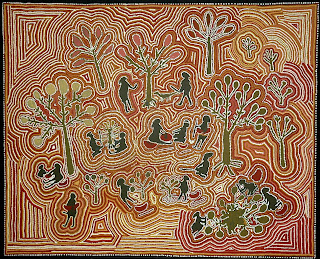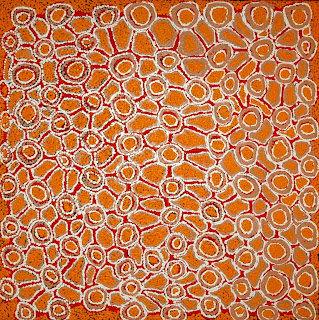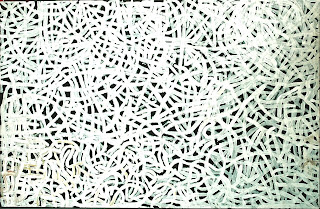 As Hank Ebes, founder of the Aboriginal Gallery of Dreamings (AGOD), holds a second clearance sale of works from his Cheltenham warehouse, it is hard to know whether to be saddened or elated. After all, the closing of AGOD marks the end of an era - and of an extraordinary institution. Looking through the works on the block, however, is enough to blow away those doldrums. The 353 lots in the catalogue summarize the historical emergence of the Western and Central Desert art movements and the painting cultures of the Kimberly and Top End. This post inspects a few of the works that captivate me - but don't let my choices keep you from taking your own tour of the auction lots. And as this is only the second of a series of ten projected auctions of works culled from Mr. Ebes collection, there are more treasures to come.
As Hank Ebes, founder of the Aboriginal Gallery of Dreamings (AGOD), holds a second clearance sale of works from his Cheltenham warehouse, it is hard to know whether to be saddened or elated. After all, the closing of AGOD marks the end of an era - and of an extraordinary institution. Looking through the works on the block, however, is enough to blow away those doldrums. The 353 lots in the catalogue summarize the historical emergence of the Western and Central Desert art movements and the painting cultures of the Kimberly and Top End. This post inspects a few of the works that captivate me - but don't let my choices keep you from taking your own tour of the auction lots. And as this is only the second of a series of ten projected auctions of works culled from Mr. Ebes collection, there are more treasures to come.Before perusing the paintings, though, a sketch of their collector is in order. Adrian Newstead of Coo-ee Gallery in Bondi Beach has said of Ebes: "He's the sort of bloke who makes money. He's a lone ranger; you love him or you hate him. Most people in the 'official' part of the [Aboriginal art] industry don't like him - I'm hesitant to say loathe him." To say that Ebes' backstory is unusual for a gallerist is an understatement. Born in Holland, he moved to the U.S. where, in the late-'50s, he delivered flowers and trekked through neighborhoods selling door-to-door, working illegally without a green card. With immigration authorities hot on his tail, Ebes fled to Australia in the early-'60s. After trying his hand at zinc mining and crop dusting, he made a his first killing by marketing 'Pong' to andtipodean videogamers. Using the proceeds to buy antiquarian books and prints, Ebes enraged art dealers by buying historical volumes and cutting them apart to sell the prints individually - a practice called "bookbreaking." Selling off the contents of four books by the 19th century ornithologist John Gould, Ebes generated $1.6 million from an initial $550,000 investment, completing the transactions just weeks before the 1987 stock market crash.
 Michael Nelson Jagamarra
Michael Nelson JagamarraMichael Nelson Jagamarra's Yam Dreaming crackles with the jagged energy of desert life rather than Maralinga's forces of destruction. The desert yam (Ipomoea costata or 'bush potato'), harvested throughout the year, was a staple food for Aboriginal nomads throughout Central Australia. Its importance is reflected in proprietary dreamings, ritual ceremonies held to insure the plant's productivity, and paintings devoted to this vegetal spirit being and its associated sites. In this iteration of the Yam Dreaming story, Michael Nelson Jagamarra endows us with x-ray vision. A bulls-eye roundel marks the point at which the plant pulunges into the desert soil. Tuberous roots branch outward, forcing their way to the edges of the canvas. Seemingly monochromatic, the canvas upon closer inspection (click on the image for an enlargement) is flecked with a few invigorating red spatters that bring it to life.
Britten, a life-long stockman turned painter in retirement, was a traditional custodian of the Bungle Bungle Range, a unique landscape of horizontally banded, beehive shaped sandstone formations towering over the Ord River grasslands. Like other artists of the Warmun Art Center, Britten used locally collected natural ochres, ground into a pigment and mixed with a binding medium, to create paints that quite literally infused his canvases with local color. Britten went even farther, sometimes adding kangaroo blood to red ochres. These ritually evocative materials convey the multivalence of Britten's work, which is as layered as the sandstone landforms it portrays. His charming representation of an iconic Kimberly landscape is simultaneously an expression of gnarangani (dreaming) sagas and events.
 Jack Dale
Jack DaleLike Jack Britten, Jack Dale Mengenen worked as a Kimberly stockman in a remarkable life that bridged two cultures. The son of Moderra, an Ngarinyin woman, and Jack Dale, a Scottish immigrant, Dale the younger grew up at a time when white cattlemen imprisoned and sometimes killed indigenous people for attempting to exercise their rights as traditional custodians of country transformed by pastoral use. His childhood abuse ended with his father's death, when Jack escaped to the bush. Raised and taught traditional ways by his maternal grandfather, he became respected both as a skilled stockman and an initiated tribal elder. He is a traditional custodian of Imanji, located near the Mt. House Station ranch worked by his father. Map of Country delineates the spiritual cartography of the site with terse forms rendered in natural ochres and synthetic polymers: a palette of materials as culturally hybrid as the artist's life.






















-Gugaman_196-09_web.jpg)






